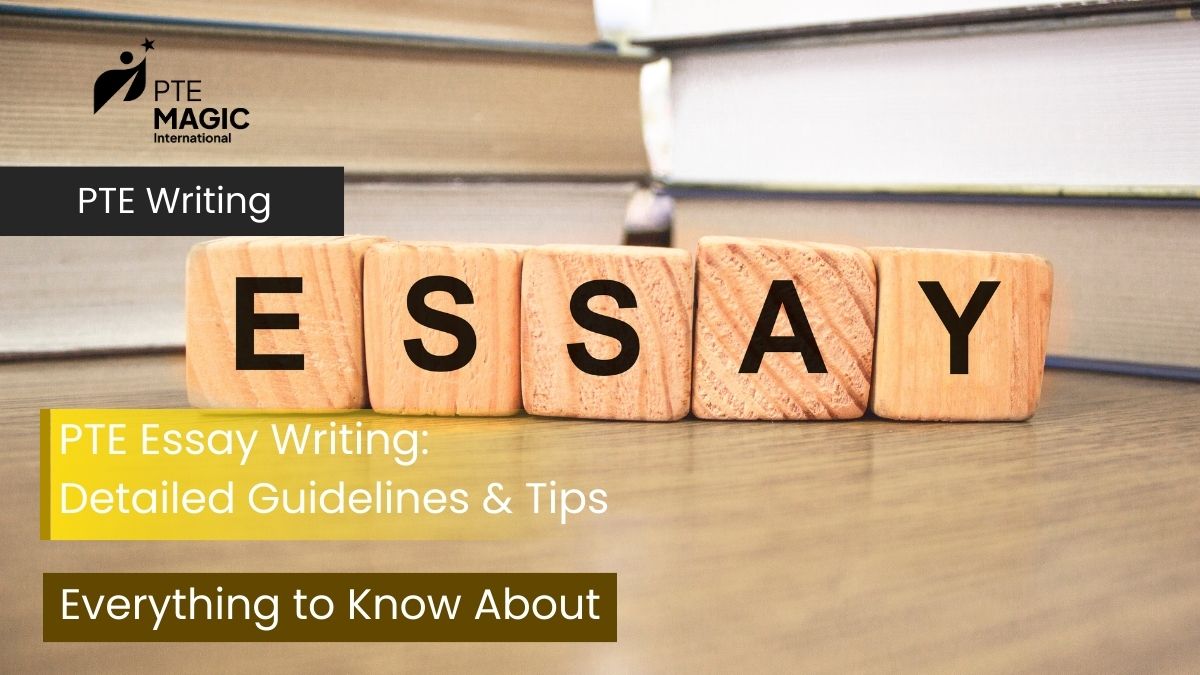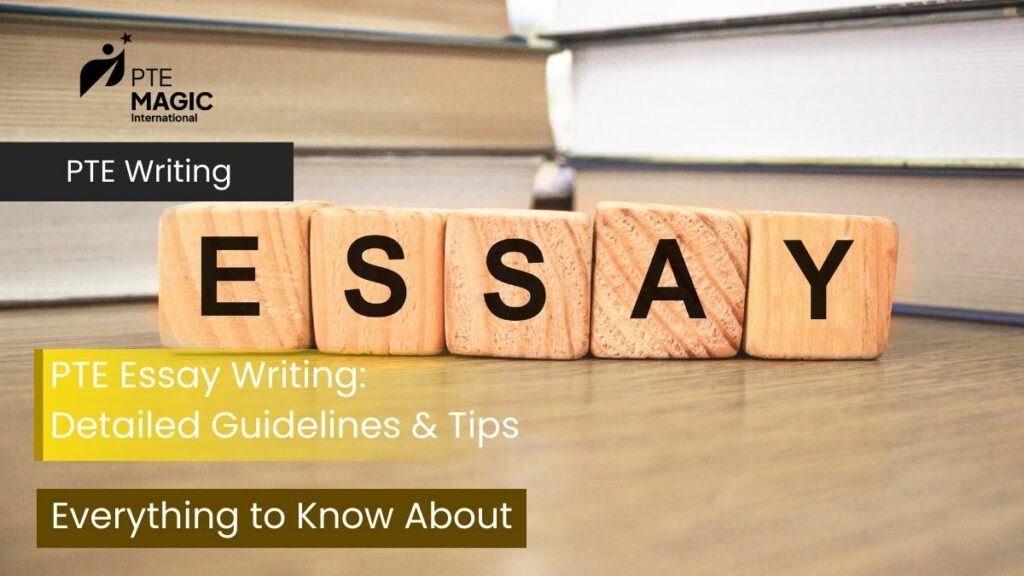No courses in the enrolment list.
PTE essay writing is an important part of the PTE test.
It is designed to evaluate grammar, vocabulary range, and the ability to develop ideas of the participants. It can be a big challenge for all people who take the PTE test.
However, you can get a high score for this part if you practice the right way.
In this guide by PTE Magic, you will find all the things you need to conquer PTE essay writing.
Let’s take a look.
|
How to FINALLY Pass the PTE and Achieve Your Dreams
Stop guessing! Start using proven methods that guarantee results!
✅ Master Every Section: Discover INSIDER SECRETS that secure HIGH SCORES. ✅ Save Time & Effort: Study SMARTER with proven strategies for FAST results. ✅ Real Practice, Real Confidence: Practice with TEST-LIKE questions to feel FULLY PREPARED.
START YOUR PTE SUCCESS JOURNEY TODAY
|
Key Takeaways
- PTE Essay Writing evaluates grammar, vocabulary range, and ability to develop participants’ ideas.
- The essay writing often follows a standard format, including an introduction, body paragraphs, and a conclusion.
- PTE essay writing has a detailed and transparent scoring system. See the breakdown of how your PTE essay will be scored below.
Related:
- Online PTE training courses that get results!
- Secrets to cracking the PTE test with ease
- PTE writing test – everything you need to know
PTE essay writing structure & word limit
Before diving into specific strategies, you need to know the PTE essay writing structure.
In this task, you have to respond to a given prompt in the most logical way. The essay writing often follows a standard format, including an introduction, body paragraphs, and a conclusion.
The details of each part can be:
Essay introduction
The introduction should be about 1-2 sentences, starting with a statement related to the topic and giving an opinion about the mentioned issue. Notice that your point needs to be clear, brief, and focused on the task.
The essay body
The body paragraph is usually between 200 and 300 words in length. You can divide it into two single paragraphs, each of which gives an idea supporting the main point of your thesis statement.
You can refer to the below writing structure:
- The first sentence of the paragraph mentions one reason why you state as in the introduction.
- The following sentence explains and clarifies the reason in the first sentence.
- The next sentences provide some specific evidence and examples to illustrate the idea. This strengthens your idea and helps it be more coherent.
The body is the most important part of PTE essay writing. Therefore, you should practice and strive to write as smoothly as you can.
Essay conclusion
The last of the essay is the conclusion. In this part, you should restate your thesis statement in different words to emphasize your main argument and summarize the key points you made in the body paragraphs.
This part should contain about 1-2 sentences.
Word limitation in essay tasks is an important factor you need to notice. It’s better when you write in that range, not less or more.
How will your essay be scored in a PTE test?

Since you understand all about the essay structure, you need to know how the examiner scores you.
PTE essay writing has a detailed and transparent scoring system. The scoring process involves both automated scoring and human raters.
Here’s a breakdown of how your PTE essay will be scored:
Your essay content
This is the most important part of the score frame. It can comprise up to 3 points (the others usually occupy 2 points for each aspect).
Content factor evaluates the relevance and adequacy of your response to the given essay prompt. You will be scored on how well you address the topic in providing relevant information and giving your supporting ideas with examples and details.
In case you are not focusing on the given topic, or writing rambling, you might lose points.
Formal essay requirements
Formal requirement assesses the structure and organization of your essay. It also refers to how many words you write in the paragraph. The ideal is your writing in about 200 to 300 words. If it is not in this range, you will receive a lower score or even zero in some cases. More specific:
- If the response is between 200 and 300 words, you will gain 2 points.
- You will receive 1 point if your paragraph contains 120-199 words or 301-380 words.
- You will receive a zero if you write less than 120 words or more than 380 words, using bullets in the paragraph.
Grammar
The grammar score assesses how master you write English. It is based on your use of verb tenses, subject-verb agreement, word order, and other grammatical aspects.
Below is the detailed range score:
- 2 if the test-taker has excellent grammar usage and it’s hard to find any errors.
- 1 if you demonstrate quite good grammatical control and there is no mistake leading to misunderstanding.
- 0 if you have some basic mistakes and use a too-simple structure.
Vocabulary
This aspect evaluates your use of a wide range of vocabulary, as well as your ability to use words and phrases appropriately. The vocabulary score considers the complexity and appropriateness of your word choices.
You will get/score:
- 2 if you can apply idioms, collocations, and phrases in an appropriate way.
- 1 if you use a wide range of vocabulary connecting to the topic.
- 0 if you only use simple vocabulary, not enough to handle the task.
Spelling
This part appraises the accuracy of your spelling. It’s important to avoid spelling errors to maximize your score.
- 2 if there are no misspelled words.
- 1 If there is a single spelling word mistake and the response has several typing errors.
- 0 If the response includes many misspelled words and typographical errors.
Development, structure, and coherence
In this aspect, test-takers need to show how well they elaborate on their ideas and arguments, their idea organization skill, and how well their ideas flow and connect throughout the essay. You will gain:
- 2 if the answer exhibits a coherent organization and effective elaboration of concepts.
- 1 if the answer lacks a suitable organization and the ideas are connected in an unsuitable manner.
- 0 if the paragraph is not in a logical structure.
General Linguistic Range
This particular aspect is valued and given a score based on how accurately the response communicates the test taker’s thoughts or concepts. The score range is from 0 to 2:
- 2 if the paragraph presents ideas, emphasizes critical aspects, and eliminates any ambiguity.
- 1 if the paragraph shows a reasonable linguistic range, clearly expresses the viewpoint, and includes valid arguments to support the statement.
- 0 The response employs basic language and lacks precision.
5 important steps to follow when writing your PTE essay

Step 1: Analyze and understand the prompt
First of all, you have to read the topic carefully to understand. Make sure you know the meaning of the prompt.
There are some popular types of essays you can see such as argumentative, persuasive, descriptive, and so on. You need to identify clearly what type of essay you write after reading the prompt.
Step 2: Brainstorm ideas
After analyzing the prompt and knowing what type of essay you would write, take a few minutes to brainstorm ideas related to the topic.
What is your stand? Why do you choose this? How will you explain and support your idea in the paragraph?
Give and answer such questions independently to shape and expand your idea.
Don’t forget to jot down key points, arguments, examples, and any relevant information that comes to mind.
Step 3: Create an outline
This is one of the most essential parts of this task. It’s like a skeleton of the writing. An ideal outline will help you write the essay more smoothly. It also assures you cover all the necessary points.
All you need to do is organize your thoughts and ideas into a clear and structured outline.
Step 4: Write paragraphs following the outline
This step requires you to write carefully, using the ideas you listed in the outline.
In the introduction, state your opinion clearly. Try to create an engaging introduction, grab the reader’s attention, and set the tone for the rest of the essay.
Moving to the body paragraphs, keep all ideas consistent. Ensure that your ideas connect logically from one paragraph to the next. Don’t forget to use transitional words (such as moreover, therefore, additionally, etc.) and phrases to improve the overall coherence of your essay.
In the conclusion, restate your opinion and avoid introducing new ideas. You should provide a concise summary of your key arguments.
Remember the score scale to organize a standard essay.
Step 5: Proofread and edit the essay
After finishing your message, take time to revise your essay’s grammar, spelling, and punctuation errors. Ensure your essay meets the word count requirement to not lose any not-worthy points.
3 Key tips for a better PTE writing score
Tip 1: Keep the essay in your PTE test as simple as you can
Simplicity is the key leading to success in PTE Writing. It’s crucial to convey your thoughts and ideas clearly and concisely. You need to:
- Keep the writing clear and coherent.
- Avoid abusing advanced words, use them only when it’s suitable to the context
Tip 2: Use a PTE writing format
Mastering the PTE writing format is paramount. In the PTE essay writing task, you need to follow the traditional essay format. It includes an introduction, body paragraphs, and a conclusion.
It’s essential to stick to the allocated word count and make sure your essay addresses the prompt directly. By adhering to the prescribed format, you demonstrate your ability to meet the test’s criteria, which can significantly boost your score.
Don’t forget to keep the score scale in mind to avoid serious mistakes, causing a low score.
Tip 3: Practice every day to improve your PTE skills
Practicing should be an integral part of your study routine. Regular practice not only improves your writing skills but also builds your confidence in tackling PTE writing tasks.
Take time to practice the sample topics and challenge yourself with various topics to become comfortable with diverse subjects and argumentation styles.
Last but not least, you can seek feedback from PTE teachers or peers to identify areas for improvement.
Consistent practice and constructive feedback can help you fine-tune your writing and steadily raise your PTE writing scores.
Conclusion
PTE essay writing is a crucial aspect of the PTE Academic test. Mastering this skill requires practice, preparation, and a solid understanding of the task.
By following the tips and strategies outlined in this blog, you can enhance your essay writing skills and increase your chances of achieving a high score on the PTE Academic test.
|
How to FINALLY Pass the PTE and Achieve Your Dreams
Stop guessing! Start using proven methods that guarantee results!
✅ Master Every Section: Discover INSIDER SECRETS that secure HIGH SCORES. ✅ Save Time & Effort: Study SMARTER with proven strategies for FAST results. ✅ Real Practice, Real Confidence: Practice with TEST-LIKE questions to feel FULLY PREPARED.
START YOUR PTE SUCCESS JOURNEY TODAY
|
Last updated on 10/03/2025

My name is Moni, and I am a seasoned PTE teacher with over 6 years of experience. I have helped thousands of students overcome their struggles and achieve their desired scores. My passion for teaching and dedication to my student’s success drives me to continually improve my teaching methods and provide the best possible support. Join me on this journey toward PTE success!



























I am a firm believer that the best teachers educate with their hearts not just their minds.
Moni | PTE MAGIC International Founder
Explore PTE
Tips & Tricks
The PTE Summarize Written Text task requires test-takers to read a text of up to...
Read more →Did you know? Many PTE test-takers lose valuable marks in the Writing section, not because...
Read more →Test-takers have 20 minutes to write an essay of 200–300 words in the PTE Essay...
Read more →